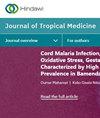Maytenus addat (Loes.) Sebsebe 叶提取物及其主要化合物的体内止泻潜力
IF 2.1
4区 医学
Q3 PUBLIC, ENVIRONMENTAL & OCCUPATIONAL HEALTH
引用次数: 0
摘要
腹泻仍然是导致五岁以下儿童死亡的首要原因之一,在发展中国家尤其如此。在埃塞俄比亚传统医学中,有多种药用植物可用于治疗腹泻。其中一种植物是 Maytenus addat (Loes.) Sebsebe(天南星科),它是埃塞俄比亚非洲峰森林,尤其是森林边缘地区的特有植物。用 80% 的甲醇浸泡 M. addat 的风干粉末叶片,可获得粗提取物。此外,粉末状植物材料还依次经过氯仿、甲醇和水的溶剂萃取,以获得溶剂馏分。采用蓖麻油诱导的小鼠腹泻模型、抗肠套叠试验和炭粉试验,对 M. addat 的 80% 甲醇叶提取物、溶剂馏分和一种分离化合物的止泻活性进行了评估。结果表明,在所有测试剂量下,80% 的甲醇叶提取物都能明显减少腹泻的发生、粪便重量和排便次数。水醇提取物的甲醇馏分和水馏分也表现出剂量依赖性止泻活性,其中甲醇馏分在 400 毫克/千克剂量时活性最高。随后,将活性最高的甲醇馏分进行 C-18 固相萃取,分离出一种 3-羟基黄酮,并通过 ESI-qToF-MS、1H 和 13C-NMR 光谱技术鉴定为槲皮素。槲皮素具有很强的止泻活性,其活性呈剂量依赖性。因此,本研究提供的证据表明,M. addat 的叶子具有真正的止泻活性,这也维护了该植物治疗腹泻的传统药用价值。研究结果还表明,槲皮素对该植物的全部或部分活性负有责任。本文章由计算机程序翻译,如有差异,请以英文原文为准。
In Vivo Antidiarrheal Potential of the Leaf Extract of Maytenus addat (Loes.) Sebsebe and Its Major Compound
Diarrhea continues to be one of the top causes of death in children under the age of five, particularly in developing nations. In Ethiopian traditional medicine, a variety of medicinal plants are used to treat diarrhea. One of these plants is Maytenus addat (Loes.) Sebsebe (fam. Celastraceae), which is endemic to the Afromontane forests, especially along forest margins, of Ethiopia. The air-dried powdered leaves of M. addat were macerated with 80% methanol to yield a crude extract. Additionally, the powdered plant material underwent sequential solvent extraction using chloroform, methanol, and water to obtain solvent fractions. The 80% methanol leaf extract, solvent fractions, and an isolated compound from M. addat were evaluated for their antidiarrheal activity using castor oil-induced diarrheal model, anti-enteropooling test, and charcoal meal test in mice. The results showed that the 80% methanolic leaf extract significantly reduced the onset of diarrhea, the weight of feces, and the frequency of defecation in all the tested doses. The methanol and water fractions of the hydroalcoholic extract also exhibited dose-dependent antidiarrheal activity, with the methanol fraction showing the highest activity at 400 mg/kg dose. Subsequently, the most active methanol fraction was subjected to C-18 solid phase extraction, resulting in the isolation of a 3-hydroxyflavone, identified as quercetin by ESI-qToF-MS, 1H, and 13C-NMR spectroscopic techniques. Quercetin demonstrated a strong antidiarrheal activity in a dose-dependent manner. Thus, the present study provided evidence that the leaves of M. addat possess genuine antidiarrheal activity upholding the traditional medicinal use of the plant for the treatment of diarrhea. The findings also suggest that quercetin is responsible, in full or in part, for the activity of the plant.
求助全文
通过发布文献求助,成功后即可免费获取论文全文。
去求助
来源期刊

Journal of Tropical Medicine
Immunology and Microbiology-Parasitology
CiteScore
3.90
自引率
4.50%
发文量
0
审稿时长
14 weeks
期刊介绍:
Journal of Tropical Medicine is a peer-reviewed, Open Access journal that publishes original research articles, review articles, and clinical studies on all aspects of tropical diseases. Articles on the pathology, diagnosis, and treatment of tropical diseases, parasites and their hosts, epidemiology, and public health issues will be considered. Journal of Tropical Medicine aims to facilitate the communication of advances addressing global health and mortality relating to tropical diseases.
 求助内容:
求助内容: 应助结果提醒方式:
应助结果提醒方式:


